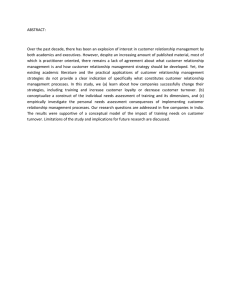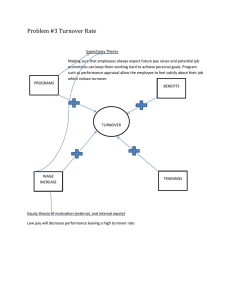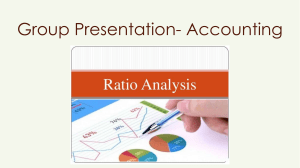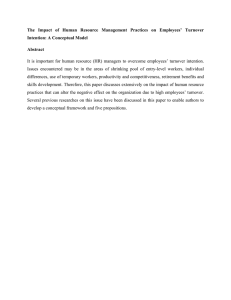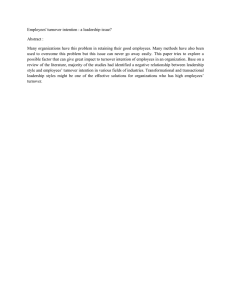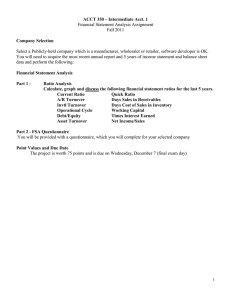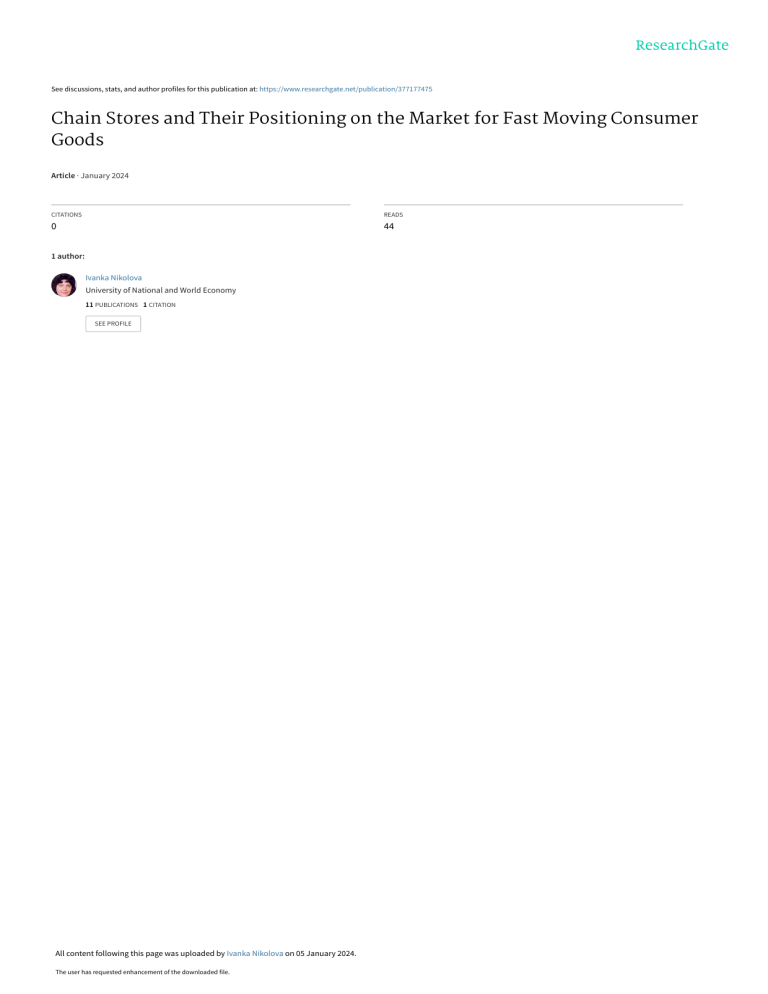
See discussions, stats, and author profiles for this publication at: https://www.researchgate.net/publication/377177475 Chain Stores and Their Positioning on the Market for Fast Moving Consumer Goods Article · January 2024 CITATIONS READS 0 44 1 author: Ivanka Nikolova University of National and World Economy 11 PUBLICATIONS 1 CITATION SEE PROFILE All content following this page was uploaded by Ivanka Nikolova on 05 January 2024. The user has requested enhancement of the downloaded file. Arcles Chain Stores and Their Positioning on the Market for Fast Moving Consumer Goods Chief Assist. Prof. Ivanka Nikolova, Ph.D. UNWE, Department of Commerce e-mail:ivnik@abv.bg Key words: chain stores, market posioning, fast moving goods, consumer behaviour, decomposion of market share. JEL: L11, L25, L81. Summary: The spreading out of foreign chain stores across the Republic of Bulgaria has triggered changes in our commerce. Chain stores influence the structure of trade, the compeve environment and the relaonships among the parcipants in the marketplace, as a result creang new customer requirements and expectaons. This arcle carries out research on the influence of some components of consumer behaviour on the market share of the chain stores in Bulgaria and their posioning on the market for fast moving consumer goods. In the period between 2005 and 2007 a change was obvious in the posioning of the chain stores on the market for fast moving consumer goods in Bulgaria – a market which can be defined as normal from the point of view of compeon and as having a low level of concentraon. The composion of the ten leading chain store companies in the country has changed. It was noced that the bigger market share of small grocery shops was due mostly to the high consumer loyal as an element of consumer behaviour. There has been a drop in the market share of small grocery shops in contrast to an increase in the share of both super- and hypermarkets and of discount shops as well. T he dynamically developing processes of trade globalizaon strengthen the trade chains as successful trade agents at a world and naonal scale. Trade chains, concentrang considerable material, financial, labour, and informaon resources, exert their influence on the structure of trade, the compeve environment, and the relaonship between the parcipants in the fast turnover goods market in Bulgaria. They are present on the market with a new product offer and different compeve advantages. Their expansion generates new consumer requirements and aitudes; the habits and lifesle of people change, as well as their behaviour in the choice of traders and place of purchase. The link between consumer behaviour and strengthening market posions of trade chains is bidireconal. Changes in lifesle, needs, values, and purchasing power of consumers in the condions of market economy smulate the development of market chains. The purpose of the present paper is to explore the influence of some elements of consumer behaviour on the market share of trade chains in Bulgaria and their posion in the fast turnover goods market. Consumer behaviour as a complex economic, social, and psychological phenomenon reflects mainly the movaons and aitudes 93 Arcles Chain Stores and Fast Moving Consumer Goods of the consumer, which drive him to react to different market situaons. The study of consumer behaviour provides traders with the necessary informaon about consumer preferences and consumer capaci, factors for the purchase, the place of purchase, the stages of making a decision, etc. The most important factor for the increase of the market share, which is a precondion for a stronger market posion of trade chains in the fast turnover goods market, is consumer capaci or the answer to the queson “How much do consumers buy?” It is directly related to the total potenal of the studied market. The total market potenal, according to markeng specialists, is the maximum quan of product sales, which would be realized for a certain period of me, at a certain level of markeng acvi in the specific industry branch, and in presence of certain environmental condions. Usually, the total market potenal, being the sum of sale potenals of companies-parcipants in the studied market, is expressed as [6, p. 304]: Q = n.q.p , where: Q – total market potenal; n – number of buyers of a specific product; q – medium quan, purchased by a buyer; p – average price per unit of product. Consumer capaci for realizing a purchase How much do consumers buy? Number of consumer units = Populaon number Consumer capaci is determined by the number of consumers, consumer requirements (necessies, desires, needs), and consumer potenal [3, p. 102]. Consumer potenal, on the other hand, includes the purchasing capaci (financial resources, which consumers have for the purchase of different products), the readiness, and the right of purchase (Figure 1). Consumer capaci of performing purchases can be presented as a theorecal conceptual model using the method of decomposion of the market share into consumer behaviour elements, used hereaer in the study (Figure 2). Needs movate and guide consumer behaviour on the market, but only needs backed by purchasing power express the real consumer power of households and socie. Market demand reflects the part of needs, which is ensured financially and, as a result, can be sasfied and turn into real consumpon. The analysis of consumpon on the market of fast turnover goods characterizes those needs, which are indeed sasfied and provides an idea of consumer selecvi and the real power of consumers. The fast turnover goods market covers the mass and everyday goods, which can be classified in the following product groups: dairy Consumer requirements + Necessies Consumer potenal + Purchasing capaci Needs or Readiness to buy Desires Number of households Right to buy Figure 1. Elements of the consumer capacity of performing purchases 94 Economic Alternaves, issue 2, 2009 Arcles products, packaged foods, alcohol beverages, non-alcohol beverages, personal hygiene and cosmecs products, and products for household maintenance. In 2007, the consumpon of fast turnover goods amounted to 2202843 thous. leva, a growth in absolute value by 91310 thous. leva, or a relave growth by 4.3 %, with respect to 2006 [10]. The relave share of the observed fast turnover goods in 2006 is 47.6 % of the total consumpon in the country, which amounts to 4439361 thous. leva. In 2007, the consumpon of fast turnover goods marks a slight drop to 45.7 % of the total consumpon, but there is a growth in absolute value to 4818580 thous. leva. Or, just in one year, there is growth in the consumpon of fast turnover goods in absolute value, and an insignificant decrease of its relave share in the total consumpon of the country. The observed market of fast turnover goods is almost 50 % of the total consumpon in the country, which demonstrates the importance of the present study. The analysis of the consumpon of fast turnover goods by product groups shows that nonalcohol beverages occupy the highest share of the purchased quanes of fast turnover goods, which for the period 2005-2007 is about 40 % (Table 1). The consumpon of non-alcohol beverages grows gradually both in quan and in absolute value. The second place in 2007 is occupied by the consumed quan of dairy products – 26.6 %, the third and fourth place, respecvely, by the consumed quanes of packaged foods – 17.2 %, and alcohol – 9.2 %. The indicated structure of purchased quanes by product groups remains the same for the period 2005-2007 with insignificant deviaons from the menoned relave shares. The conclusion follows that the highest quanes of fast turnover goods are purchased from the groups: non-alcohol beverages, dairy products, packaged foods and alcohol. The consumpon measured by prices has a different structure. The highest share of household expenses is for the purchase of packaged foods, which in 2007 represent 43.3 % of the expenses for fast turnover goods (Table 1). The second place is occupied by dairy products – 25 %. The third and fourth place is occupied by expenses of households for nonalcohol beverages – 10.4 % and for personal hygiene and cosmecs products – 8.5 %. For the period 2005-2007, the structure of the consumpon of fast turnover goods by product groups measured in value is like the described above: the highest expenses of households are Table 1. Structure of the consumption of fast turnover goods in the country – quantity and value for the period 2005-2007 Product groups Dairy products Packaged foods Alcohol Non-alcohol beverages Personal hygiene and cosmecs Home care products Purchased quan (%) Expenses (%) 2005 2006 2007 2005 2006 2007 27.2 18.8 9.2 38.2 1.2 5.3 26.9 18.1 10.0 38.4 1.1 5.3 26.6 17.2 10.0 40.4 1.1 4.5 24.4 44.2 5.5 9.3 9.2 7.4 25.1 43.5 5.7 9.3 8.8 7.5 25.0 43.3 6.0 10.4 8.5 6.9 Source: Adapted from Kolev, V., The market in 2007 according to data from GfK Bulgaria, Journal Regal, Special Edition, 2007 , pp. 2-19. 95 Arcles for the purchase of packaged foods, followed by dairy products, non-alcohol beverages, and products of personal hygiene and cosmecs. The differences between the structure of consumpon in quan and value reflect, in principle, the influence of the change in the prices of the respecve products on the levels of their consumpon. An example in this respect is provides by the group of dairy products, which for the period 2005-2007 marked an increase in their price consumpon from 24.4 % to 25 % and a decrease of their consumpon in quan from 27.2 % to 26.6 %. The structure of consumpon in quan reflects the choice made by consumers and the really sasfied needs of the populaon in fast turnover goods. Fast turnover goods are everyday goods of mass use and, in their essence, they sasfy mainly physiological needs, which is a precondion for their relavely constant consumpon structure in quan. Consumer selecvi with respect to fast turnover goods is related mainly to preferences for certain brands and quali of products, affecng to a lower degree the product range. The structure of consumpon in value emphasizes, in principle, commodies and product groups, which contribute to the increase in the volume of sales and the market shares of the respecve trade companies, and also directly affect their market posions. As a summary of what has been said above, it is necessary to point out that consumer capaci of performing a purchase of fast turnover goods is limited, as these commodies sasfy the physiologic needs of the populaon and these needs have their limits. On the other hand, the fast turnover goods market is an aracve market, as at present in our country it holds almost 50 % of the total household consumpon in the country. Consumers appreciate fast turnover goods as everyday commodies and, in 96 Chain Stores and Fast Moving Consumer Goods this respect, the elasci of their demand with respect to price is relavely low, which allows traders to benefit from this fact and increase prices for higher profit. The supply on the fast turnover goods market is characterized by the presence of ten leading trade companies in the country, which in 2007 had 19.7 % of the fast turnover goods consumed by the households. These are the trade chains Kaufland, CBA, Billa, Metro, Fantasco, T-Market, Piccadilly, Burlex, Familia, and HIT. In 2005, not all of the listed trade chains had stores in the country and, for this reason, the TOP 10 had only 13.7 % of the total consumpon of fast turnover goods. There is a trend towards increase of their relave share in 2006 by 2 percentage points, and in 2007 – by 4 percentage points. The increase is more clearly expressed in the first quarters of 2006, 2007, and 2008; when also a restructuring of the TOP 10 companies is observed. In 2005, Metro had the highest share – 3.7 %, followed by Billa – 3.3 %, and CBA – 2.9 %. In 2006, Kaufland entered the Bulgarian market and as early as in the first year achieved a relave share in the household consumpon of fast turnover goods, amounng to 1.4 %. It should be noted that Metro gave up the first place in 2006, as a consequence of the decrease of its relave share by 0.6 percentage points (from 3.7 % to 3.1 %), and Billa occupies the leadership posion with 3.4 %, followed by CBA (3.2 %). The data in 2007 show that this was the year of Kaufland with a growth by three percentage points of its share compared to 2006 – so that Kaufland reached the first place. Billa and CBA have equal posions with 3.7 %. During this year, Metro was the only loosing part, with its share connuing to decrease and reaching 2.7 %. During the observed period of three years, Fantasco maintained a constant share amounng to 2.3 %. Economic Alternaves, issue 2, 2009 Arcles The conclusions made on the basis of the yearly data are also confirmed by the data for the first quarters of 2006, 2007, and 2008. Three groups are formed within the TOP 10: • Kaufland, disnguished by high rate of increase of its relave share – from 0.1 in 2006 to 6.2 % in 2008; • CBA and Billa – their relave share grows at a slower rate, but they sll hold the second place; • Metro with a decreasing share during the three years. The other parcipants in TOP 10 are, as a whole, characterized by a comparavely lower relave share which grows during the three years, with slight variaons for some of them. For the period 2005-2007, the market posions of trade chains in the fast turnover goods market change. The restructuring of the TOP 10 companies is a fact. The results from the analysis allow making the conclusion that Kaufland, CBA, and Billa are the leading trade chains at the present moment in our country, as in 2007 and the first quarter of 2008, they reach, respecvely, 59 % and 66 % in household consumpon of fast turnover goods purchased from the companies making part of TOP 10. Different trade formats turn out to be successful at different stages of development and for different countries. Their varie is a reflecon of consumer demand, bringing about development and increasing the number of channels for realizaon of goods and services. At the present stage of development, the following more important trade formats are established: supermarkets&hypermarkets, discounters, Cash&Carry, minimarkets; small grocery shops, open market&street vendors, and others. The present study focuses on the structure of trade formats, the size of their market share in the fast turnover goods market for the period 2005-2007, and the dynamics of this structure. In 2007, the market share of the small grocery shops in our country was several mes higher (47.7 %) than the share of supermarkets&hypermarkets, occupying the second posion (19.2 %). This fact is due to established shopping habits, predetermined to a great degree by the lifesle in our country. The prevailing small grocery shops in principle demonstrate the insufficient resources and not so favourable business environment for the expansion of trade in our country, but on the other hand, their prevailing share corresponds to the exisng market demand. For the period 2005-2007, as a result of foreign trade chains expansion, a decline in the market share of the small grocery shops (from 50.1 % to 47.7 %) is observed on account of the increase of the market share of supermarkets&hypermarkets (from 17.2 % to 19.2 %), and of discount stores (from 1.4 % to 4.4 %) represented by Kaufland. Minimarkets hold a stable market posion with a market share varying from 11.9 % to 14.1 %, which indicates that they are posioned in the strict market segments. In the condions of transion to market economy, the lifesle, needs and preferences of buyers change. The onset of European trade chains with different formats limits the market presence of local stores and street markets. Strengthening the compeon between the parcipants in the fast turnover goods market is also expected. The Herfindahl-Hirschman index and the concentraon rao of the 3 and 4 companies with the highest market share – CR3 and CR4 – are used to determine the intensi of compeon in the fast turnover goods market. The Herfindahl-Hirschman index is calculated as an arithmec mean of relave shares, weighted by the same relave shares [1, p. 133]. 97 Arcles Chain Stores and Fast Moving Consumer Goods k ∑vivi k CN = = ∑vi2 ; ⎛ ∑vi= 1⎞ i=1 ⎝ i=1 ⎠ ∑vi i=1 k k , i=1 where vi are the respecve relave shares ( %). The index can assume the value from 0 to 1/k, where k is the number of elements of the studied structure. These are the two extreme states – full steadiness and lack of concentraon of all units only in one group, which is an expression of full concentraon. The following limits are used for the interpretaon of the index, characterizing the degree of concentraon of the relevant market [5, pp. 112-113]: - СN <1000 – normally compeve market, low level of concentraon; - СN =1000÷1800 – relavely compeve market with medium level of concentraon; - СN >1800 – weakly compeve market with high level of concentraon. Comparing the Herfindahl-Hirschman index, calculated for the different years is used to reveal the dynamics in the level of concentraon, caused by the influence of different factors. Another indicator for the evaluaon of market concentraon is the market share of the 3 (CR3 – Concentraon Rao) or 4 trade companies (CR4) with the highest volume of sales [5, 113-114]. k CRk = ∑ Pi , i=1 where k is the number of the largest parcipants in the respecve market (the parcipants with the highest market share); Pi is the market share of the ith parcipant. The CR unlike HerfindahlHirschman index is not characterisc of all the 98 relevant market, but only of the posion of the largest parcipants in it. Based on the values of CR3 and CR4, three pes of markets can be defined: - Normal compeve market, with CR3<40 and CR4<50; - Relavely compeve market with medium level of concentraon – CR3=40÷70 and CR4=50÷85; - Weakly compeve market, with high level of concentraon – CR3>70 and CR>85. For the period 2005-2007, the HerfindahlHirschman index calculated for companiesparcipants in the fast turnover goods market, gradually increases. The values for the respecve years are 39.6, 40.1, and 61.8. Despite this growth, the calculated coefficients are far below the lowest limit of the Herfindahl-Hirschman index (СN <1000). This fact shows that the fast turnover goods market is a normal compeve market with low level of concentraon. This conclusion is also confirmed by the calculated concentraon raos CR3 and CR4. Unlike Herfindahl-Hirschman indexes, they do not characterize all the fast turnover goods market, only the posion of the three/four largest parcipants. For 2005 and 2006, CR3 is calculated based on the market shares of Metro, Billa, and CBA, while in 2007 – on the market shares of Kaufland, CBA, and Billa. The concentraon rao CR3 during the period under exploraon takes the values 9.9, 9.7, and 11.8, which allow the fast turnover goods market to be defined again as a normal compeve market with low level of concentraon (CR3<40). The concentraon rao CR4 takes the values 12.3, 12.0, and 14.5, confirming the pe of the studied market (CR4<50). The trade companies parcipang at present in the fast turnover goods market do not have a significant market share to strongly influence the Economic Alternaves, issue 2, 2009 Arcles market structure and market condions including prices of fast turnover goods. The major share of small grocery shops and minimarkets demonstrate the fragmentaon of trade in our country. The incoming foreign trade chains contribute, on one hand, to the consolidaon of capital in trade, to its higher concentraon, as well as to the increasing intensi of compeon, but on the other – they take market share and development opportunies away from naonal traders. The parcipants on the market of fast turnover goods are faced with compeon for higher market share and changing market posions. The markeng concept considers the customer, his preferences, sasfacon, and behaviour, being the most important for the outcome of this rivalry. In this respect, the market share is explored as a funcon of the following parameters of consumer behaviour[7, p. 147]: degree of consumer penetraon, degree of consumer loyal, degree of consumer selecvi, and degree of price selecvi (Figure 2). In the specialized literature, the elements of consumer behaviour in the decomposion of the market share can be interpreted according to Market share Degree = of consumer penetraon the purposes of the different studies. One of the applicaons of the menoned decomposion of the market share is in the analysis of consumer sasfacon and, more parcularly, studying the link between the aachment of the customer to a certain brand and its market share. In this case, the respecve elements of consumer behaviour are understood as [8, p.186]: • Consumer penetraon – the percentage of buyers of a certain brand in all buyers of generic product; • Consumer loyal – purchases of a certain brands by “own” buyers as a percentage of their total purchases of a given generic product; • Consumer selecvi – the average size of purchases of a certain brand as a percentage of the average purchases of a generic product; • Price selecvi – average price of the brand as a percentage of the average industry branch price. In the specific case of the applied decomposion of the market share by GfK, the degrees of consumer and price selecvi are presented as a summary by the so called “intensi raos” (Figure 3). Degree x of consumer loyal Degree x of consumer selecvi x Degree of price selecvi Figure 2. The market share as a function of some parameters of consumer behaviour Market share Degree = of consumer penetraon Degree x of consumer loyal x Intensi rao Figure 3. Decomposition of the market share, applied by GfK Bulgaria Consumer Tracking – Bulgarian Retail Report – 2007/2008 99 Arcles Chain Stores and Fast Moving Consumer Goods It is supposed that one of the arguments for such a general conclusion is the established structure of the fast turnover goods market. It has been found out, using the HerfindahlHirschman indexes and the concentraon raos CR3 and CR4, that none of the parcipants in the fast turnover goods market influences significantly present market condions, including prices of supplied commodies for mass and daily use. On the other hand, the calculaon of consumer selecvi for such a broad range of fast turnover goods requires major efforts and can be the subject of a separate study. The market share of the respecve trade format is an expression of the relaon of sales under the respecve trade format to total sales of fast turnover goods for all observed trade formats (Figure 3). The link between the indicated elements of the market share is mulplicave. On the basis of an empirical study on the fast turnover goods market, the highest weight is revealed for the element “degree of consumer loyal”. The degree of consumer loyal is characterized by the relave share of customer expenses made under the chosen trade format compared to their total expenses for purchase of commodies and services [9]. The data in Table 2 show that the highest degree of consumer loyal in 2007 is demonstrated by customers of the small grocery shops – 52.4 %, followed by customers of supermarkets&hypermarkets with 25 %. The third and fourth place, according to the degree of consumer loyal, is occupied by customers of minimarkets with 20.8 % and those of discounters with 14.1 %. The small neighbourhood grocery store is disnguished, as a rule, by personal service and convenient locaon, which explains the higher degree of consumer loyal. The element “degree of consumer penetraon” is the relave share of the households which have made a purchase under a selected trade format at least once during the period under exploraon compared to the number of all households. The preferred trade formats are ordered according to the degree of consumer penetraon in the same sequence as according to degree of consumer loyal (Table 2). The highest share is the one of households having visited at least once during the year small grocery shops. The rao, expressing the degree of consumer penetraon for small grocery shops, amounts to 0.96, followed by the one of supermarkets&hypermarkets – 0.73. For minimarkets, this rao is 0.58, and for Table 2. Decomposition of the market share to trade formats in the fast turnover goods market in 2007 Trade formats Super&Hypermarkets Discounters Cash&Carry Minimarkets Small Grocery Shops Open Market Others Consumer penetraon 0.73 0.30 0.24 0.58 0.96 0.26 0.95 х х х х х х х Consumer loyal (%) 25.0 14.1 12.1 20.8 52.4 3.9 13.2 Market share (%) Intensi rao х х х х х х х 1.05 1.05 1.04 1.034 0.95 1.0 0.97 = = = = = = = 19.2 4.4 3.0 12.5 47.7 1.0 12.1 Source: GfK Consumer Tracking – Bulgarian Retail Report – 2007/2008, p. 59. 100 Economic Alternaves, issue 2, 2009 Arcles discount stores – 0.30. It is interesng to note the fact that in the present condions of limited purchasing power in the country, the degree of consumer penetraon for discount stores, offering commodies at relavely lower prices, is three mes lower than the one of small local grocery shops, meaning that three mes lower number of households in the country have visited a discount store at least once in 2007. Discount stores as a trade format could definively be preferred by customers with limited purchasing power, provided there are such funconing stores in close proximi to customers. For the first me in 2006, Kaufland – a market chain of discount stores – entered the Bulgarian market. As it was indicated in the beginning of the study, Kaufland is disnguished by a high growth rate of its market share – from 0.1 in 2006 to 4.4 % in 2007, and to 6.2 % in the first quarter of 2008. The conclusion becomes obvious that a free market niche for discounters as a contemporary distribuon channel exists in the country. The statement that the convenient locaon of the trade unit is an essenal factor for the choice of shopping place is confirmed this way. turnover goods. The intensi rao is the lowest for the small grocery shops (0.95) compared to the other trade formats, the laer having indexes of 1.0 and 1.1 (Table 2). We found out that the average expense per customer made in the small grocery shops is lower than the average expense for fast turnover goods as a whole. The small grocery shops offer a limited product range and the customer is not able to find there the necessary varie of commodies for everyday use. The calculated rao is higher than one for both supermarkets&hypermarkets and for discount stores. These trade formats definively offer a product range, which is characterized by its width and depth of offered posions. The average expense per customer made in supermarkets&hypermarkets, as well as in discount stores is higher than their average expense for fast turnover goods as a whole. The offered range allows the customer to purchase various commodies, and not only those for everyday use. According to the indicator “intensi rao”, the differences between the trade formats at present are very small and their effect on the size of their the market shares is relavely weak. The third element, “intensi rao”, summarizes the degree of consumer and price selecvi. In essence, the intensi rao expresses the frequency of occurrence of a certain phenomenon per unit of me. In this specific case, it reflects the rao of the average expense per customer made in a selected trade format to the average expense for fast Applying the method of chain replacement, we reveal the quantave influence of the specific elements characterizing the influence of consumer behaviour on changes of the market share in different trade formats. In 2007, the difference between the market share of the small grocery shops in the fast turnover goods market and the market share of supermarkets&hypermarkets was Table 3. Factor analysis of the market shares of trade formats “small grocery shops” and “supermarkets&hypermarkets” in the fast turnover goods market in 2007 Deviaon because of change in consumer penetraon Deviaon because of change in consumer loyal Deviaon because of change in intensi rao Complex influence of all factors +6.04 (25.20 – 19.16) +27.62 (52.82 – 25.20) - 5.03 (47.79 – 52.82) +28.63 The analysis was carried out by the author using data from GfK. 101 Arcles Chain Stores and Fast Moving Consumer Goods significant, amounng to 28.63 % (47.79 % – 19.16 %), which brings about the queson: what is the reason for this difference in market posions (Table 3). The differences between the market shares of these trade formats are due to the menoned elements characterizing the influence of consumer behaviour: Market share of supermarkets&hypermarkets: 19.16 % (0.73 х 25.0 х 1.05) A second factor with posive influence on the market share of the small grocery shops is the higher degree of consumer penetraon. The increase in the number of households having visited the small grocery shops at least once during the period under exploraon by 23 % [(0.96-0.73) х 100] results in the increase of their market share by 6.04 %. The influence of the decreased intensi rao is unfavourable, resulng in the decrease of the market share of small grocery shops by 5.03 %. It demonstrates the influence of the average size of the purchase and average prices. It is supposed that the lower intensi rao of the small grocery shops is due to the lower average size of purchase and/or to maintained lower average prices with respect to the other parcipants in the fast turnover goods market. Corrected market share : 25.20 % (0.96 х 25.0 х 1.05) Corrected market share : 52.82 % (0.96 х 52.4 х 1.05) Market share of the small grocery shops: 47.79 % (0.96 х 52.4 х 0.95) It becomes clear from the performed analysis that the higher market share of the small grocery shops with respect to supermarkets&hypermarkets is due mainly to the higher consumer loyal. When consumer loyal increases twice – from 25.0 % to 52.4 %, their market share grows by 27.62 %. This fact determines the element “degree of consumer loyal” as the most important in its impact on the market share and with the highest weight for the present analysis. The above analysis provides informaon on the following: • the criteria of consumers for choice of a trade unit for shopping and • changes in consumer preferences for the pe of trade format – small local stores or supermarkets&hypermarkets, represented by trade chains. Table 4. Consumers’ criteria for the choice of trade unit for shopping Criteria Territorial locaon Product range Appropriate price Rebates, seasonal sales, promoons Service staff Speed of servicing % More than one answer 72.9 50.8 42.2 36.6 21.1 15.6 Criteria Trade unit interior Fresh products supply Parking place Supply of regional products Loyal customers program % More than one answer 11.3 6.1 2.1 1.4 1.4 Source: Danchev, D., Global and local changes in retail trade, Jubilee international scientific conference “Trade in modern society: theory and practice”, Varna, 2008, p.71. 102 Economic Alternaves, issue 2, 2009 Arcles According to the studies of consumer behaviour in our country, it turns out that customers indicate as a main factor in the choice of a trade unit for shopping the proximi to their home or workplace (Table 4). It is necessary to emphasize that the criteria of buyers for choice of a shopping place are also a dynamic variable. The data in Table 4 shows that other criteria are of high importance for the choice of trade unit for shopping in addion to territorial localizaon: product range, good quali/price relaon, promoons, which are difficult to offer for small local grocery shops unlike for supermarkets&hypermarkets. In big cies, the intense everyday life makes consumers appreciate more and more the richness of product range under one roof, weekly shopping, constant promoons, which also results in a change in the established trend to buy mass and everyday goods in small local grocery shops. This trend is also confirmed by the fact that “for the period 2001 – 2007, for each newly open supermarket, 15 shops for food products occupying 20 square meters, 4 kiosks, 13 mixed shops, 3 non-alcohol beverage shops, and 2 confeconeries are closed” [4, p. 70-78]. Consumer behaviour characterizes the way in which buyers react and behave in different situaons of purchase-sale of commodies and services. In its essence, it is a complex and dynamic economic category. Changes in consumers’ lifesle influence their needs, purchasing power, habits, preferences, including the change in the criteria of choosing a trade unit and format. The present study found out that the element “degree of consumer loyal” is the most influenal for the market share of trade formats in the fast turnover goods market in our country. Traders are forced to look for new, modern distribuon channels, the use of which would make them most successful in aracng the interest of consumers, in smulang their market acvi, and “binding” them to a higher degree to the trade units. Influencing the frequency of visits and doubling purchases in the units pertaining to the same trade format, traders win consumer loyal [2, p. 431-436]. It ensures for them an increase in sales and a decrease of variaons in their volume, as well as lower sensivi of buyers to the offers of competors – also playing a protecve role in compeon. Based on the study of trade chains posions in the fast turnover goods market and the influence of some elements of consumer behaviour on the market share of trade formats used by them, the following more important general statements can be made: • During the period 2005-2007, a change took place in the posions of trade chains in the fast turnover goods market in Bulgaria. In 2006, a new parcipant entered the fast turnover goods market – the market chain of discount stores Kaufland, occupying the leadership posion in 2007. There was a restructuring in the list of the ten leading trade companies in the country, which sold 19.7 % of the fast turnover goods consumed by the households in 2007. The trade chains Billa and CBA occupy the second place, and Metro stays at the third place. • The Herfindahl-Hirschman index and the concentraon raos of the 3 and 4 companies with the highest market share – CR3 and CR4, characterize the fast turnover goods market in Bulgaria during the period under exploraon as a normal compeve market with low level of concentraon. • The higher market share of small grocery shops with respect to supermarkets&hypermarkets is due to higher consumer loyal. When consumer loyal goes up twice – from 25.0 % to 52.4 %, the market share of the small grocery shops grows by 27.62 %. This fact shows the degree of consumer loyal as the consumer behaviour element with most significant impact at present on trade formats market share in the fast turnover goods market. 103 Arcles • For the period 2005-2007, as a result of the arrival of foreign trade chains, the market share of small grocery shops went down (from 50.1 % to 47.7 %). This occurred mainly due to the increase of the market share of supermarkets&hypermarkets (from 17.2 % to 19.2 %), as well as of discount stores (from 1.4 % to 4.4 %), namely Kaufland. The presence of European trade chains of different trade format limits the market presence of local stores and street markets. Stronger compeon can be expected between the parcipants in the fast turnover goods market. In the condions of market economy, consumers appreciate more and more the compeve advantages of trade chains, which also leads to a change in the established trend of buying mass and everyday goods in small local grocery shops. Chain Stores and Fast Moving Consumer Goods Retailing, New York, Macmillan Publ. Co., 1991, p. 100. 4. Danchev, D., Global and local changes in retail trade, Jubilee internaonal scienfic conference “Trade in modern socie: theory and pracce”, Economic Universi, Varna, 2008. 5. Commission on protecon of compeon, Sofia, 2001. 6. Kotler, Ph., Markeng Management: Analysis, Planning, Implementaon, and Control, (in Bulgarian), Volume 1, Graphema, Sofia, 2000. 7. Mladenova, The Increase of the market share as a markeng goal, Scienfic Works, UNWE, 2000, aer: Kotler, Ph., Markeng Management: Analysis, Planning, Implementaon, and Control, 6 ed., Prence – Hall Internaonal, p. 733. Literature 1. Gatev, К., Methods of stascal analysis of economic and social structures, Nauka i Izkustvo, Sofia, 1987. 2. Galabova V., Loyal of customers to retail trade companies, Jubilee internaonal scienfic conference “Trade in modern socie: theory and pracce”, Economic Universi, Varna, 2008. 3. Danchev, D., Economics of trade, First part, Varna, 2003, adapted from Lewison, D., 104 View publication stats 8. Mladenova , Markeng analyses, Trakia – М, Sofia, 2000. 9. GfK Bulgaria. Consumer Tracking – Bulgarian Retail Report – 2007/2008. 10. The calculaons are done by the author based on data from GfK; for more details see the source: Adapted from Kolev, V., The market in 2007 according to data from GfK Bulgaria, Journal Regal, Special Edion, 2007, pp. 2-19. Economic Alternaves, issue 2, 2009
